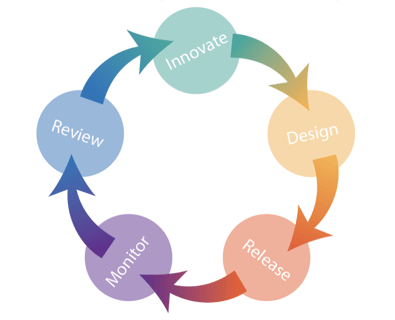You’d be hard put to find a business whose goal wasn’t to think up a plan, execute a plan, and see an ROI. Not only that, to grow, businesses need to improve: expand their clientele, upgrade their product, iron out the bugs, and think up their next product or service, keeping the business fresh.
With this recipe in mind, let’s look at the ingredients to conceive and grow a business

A good idea comes from innovating. Innovating leads to designing. Designing leads to the release of a product or service. Once the product or service has been released, it needs to be monitored, taking note of how well it does. Once there’s enough data from monitoring the release, review and repeat, heading back to the innovation table to come up with a better or new design.
Now, what do these steps look like with a team?
The process of innovating and releasing a product or service involves a series of key meetings that strengthen, cultivate, and multiply ideas.
Innovation meetings
Innovation meetings are where it all begins: they’re when two soon-to-be partners dream up a one-of-a-kind business idea, or an already booming business thinks of a game-changing product or service.
When it comes to teams, multiple minds are almost always better than one. It’s like trying to edit your own writing: if you stare at your work long enough, you miss your own mistakes. You miss how to make your writing better and more powerful than you alone could.
Innovation meetings are where teammates pool their ideas together, bouncing thoughts back and forth until they become something practical. Something incredible. They’re where ingenuity happens.
Problem-solving meetings
Once your team has an idea, they need to make it a reality. Problem-solving meetings are where teammates point out a design’s shortcomings, loopholes, and problems. These meetings are where teammates discuss the hows and whens of the project, transforming it into something solid enough to become a reality.
These meetings are where designs happen. While the team designs a project, barriers are overcome and hurtles are jumped until the product or service grows into something doable.
Kickoff meetings
Kickoff meetings are exciting; they’re stressfully exciting. These meetings are huge landmarks for any business. Kickoff meetings are scheduled when the product or service is set to be released. They’re a landmark for when months or years of hard work pay off as the product or service is set free into the world.
These meetings can be faced with a lot of stress and trepidation as the team pushes for a smooth launch. Sometimes pizza is involved, sometimes the team hosts live feed for the rest of the company to listen in, and often there’s a celebratory email sent out with a successful kickoff.
Once these meetings are over there’s no turning back: the product will have made an impact on the world, no matter how small. Any bugs or errors that were missed may be revealed, and any truly impressive ideas will be admired by customers and clients.
Status-update meetings
Depending on how well the product or service was designed, status-update meetings can be just as stressful as kickoff meetings. After a product or service has been released, anything can happen, either good or bad. Your team will monitor the product or service, keeping an eye on how well or poorly it’s received. Your customer support must be at-the-ready, awaiting any bugs, failures, or unhappy customers.
Alternatively, your release could be met with ranging success as customers rave about your product or service. Your ROI could double… triple. A status update meeting is simply where teammates gather to share the results of the release.
Retrospective meetings
Once you’ve gathered enough information from monitoring your release, it’s time to review the pros and cons of your product or service. What went well? What went poorly? Where is there room for improvement?
Careful, if you take that last question too far you’ll skip forward to the next step… back to innovating.
That’s it: the cycle in a nutshell. Once your team figures out what worked and what didn’t with their product or service, they can move forward with improvements, making an even better product than before. Or, if the release was a huge success, perhaps it’s time to come up with an entirely new idea to maintain the momentum.
You’ve identified the type of meeting, what’s next?
Well, it’s time to put it into action. The goal of your meeting depends on the type of it. For example, status-update meetings and innovation meetings differ a lot when it comes to outcomes and their structure. However, no matter the type of business meeting, you need to follow these 4 steps to run it efficiently:
- Create an event in your calendar, invite co-workers, and book a meeting room
- Send out a meeting agenda with clear points and outcomes
- Stay in charge of the meeting and make sure it’s actionable and on point
- After the meeting send out meeting notes that include discussed items and their objections
Conclusion
These five meeting types are key to any business looking to grow. Whether you’re a not-for-profit charity, you’re still thinking up new ideas to be more efficient and effective. If you’re a farmer who is planning the most profitable crop to plant next year, you’re innovating. Even Tim Hortons will be monitoring their release of reusable food packaging to find out if their new idea is sustainable or not.
It’s one thing to understand the cycle from innovation to review, it’s another thing to guide a whole team along the journey. Take care not to miss any of these five meeting types; keeping more than one mind at your disposal can make a good idea great.
Insights that keep your office running smoothly
Fresh content on productivity, space management, and the future of work. Perfect for managers, admins, and busy teams.
Join thousands of workplace professionals who already read the Joan blog. Unsubscribe anytime.